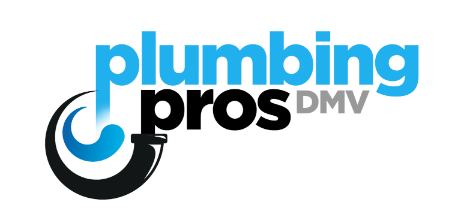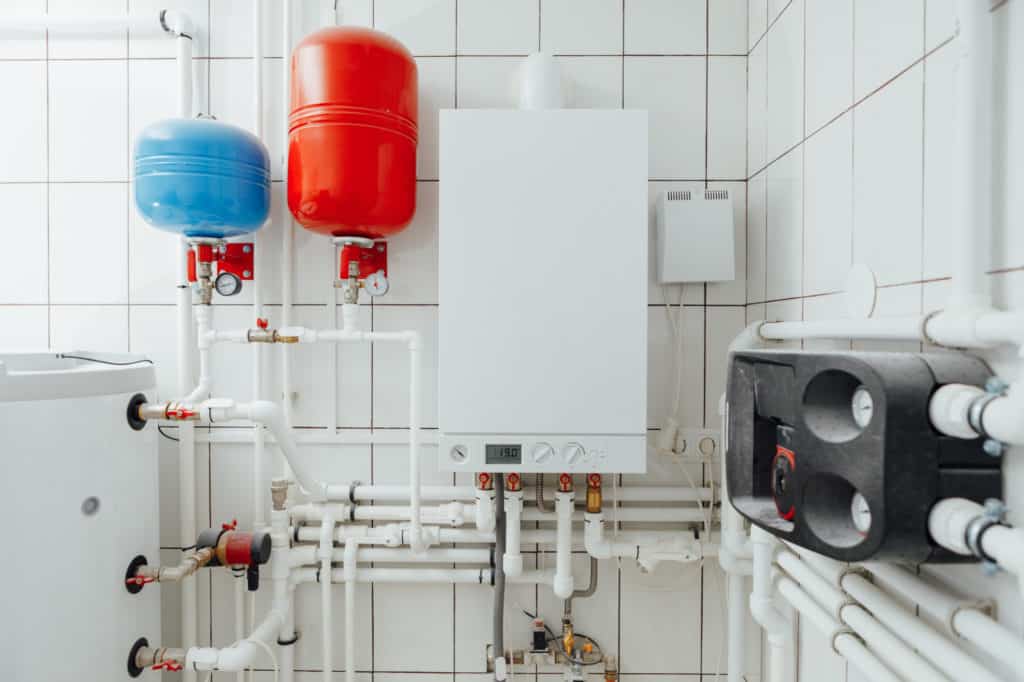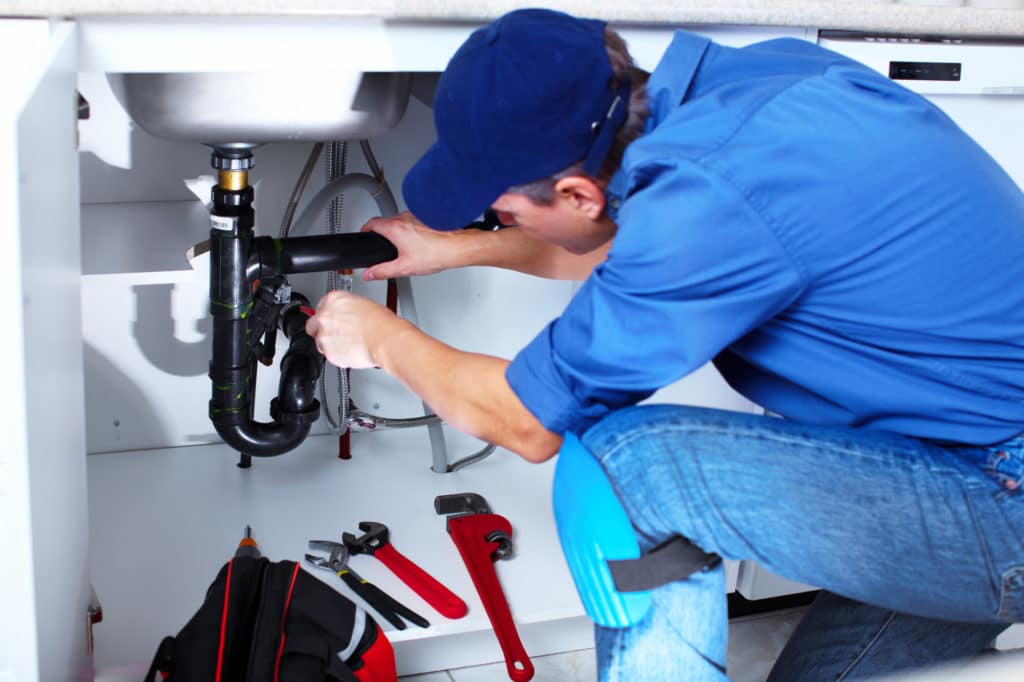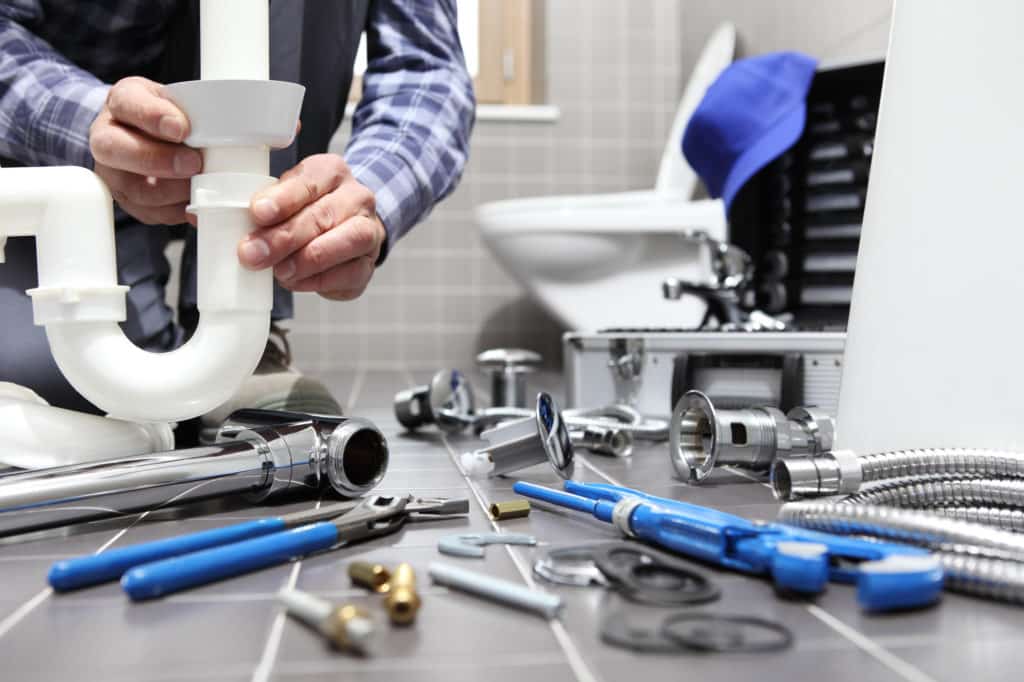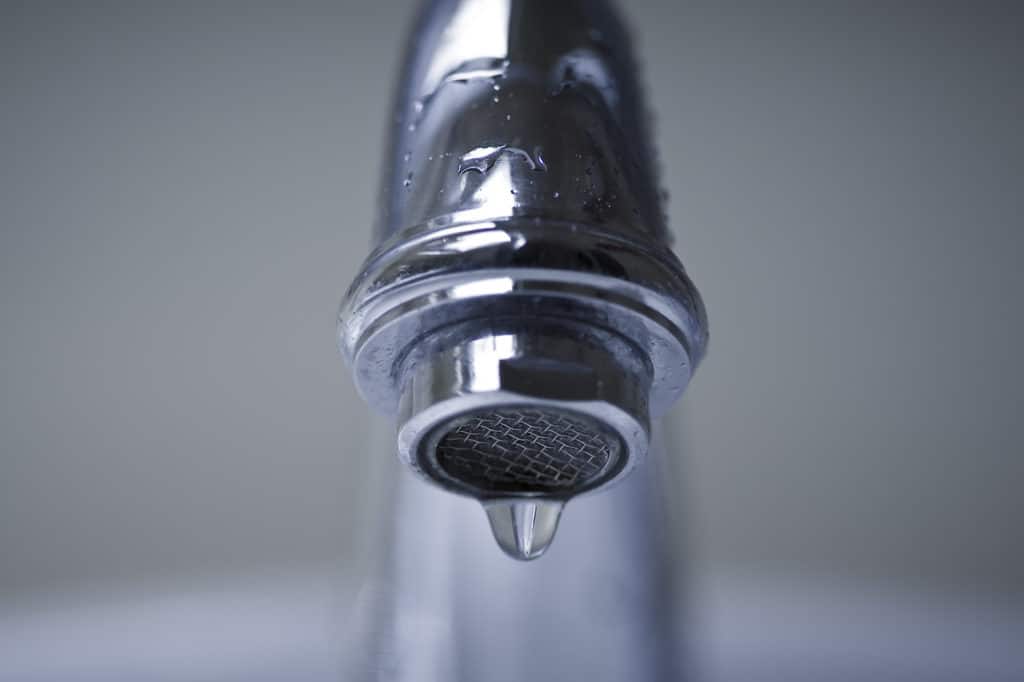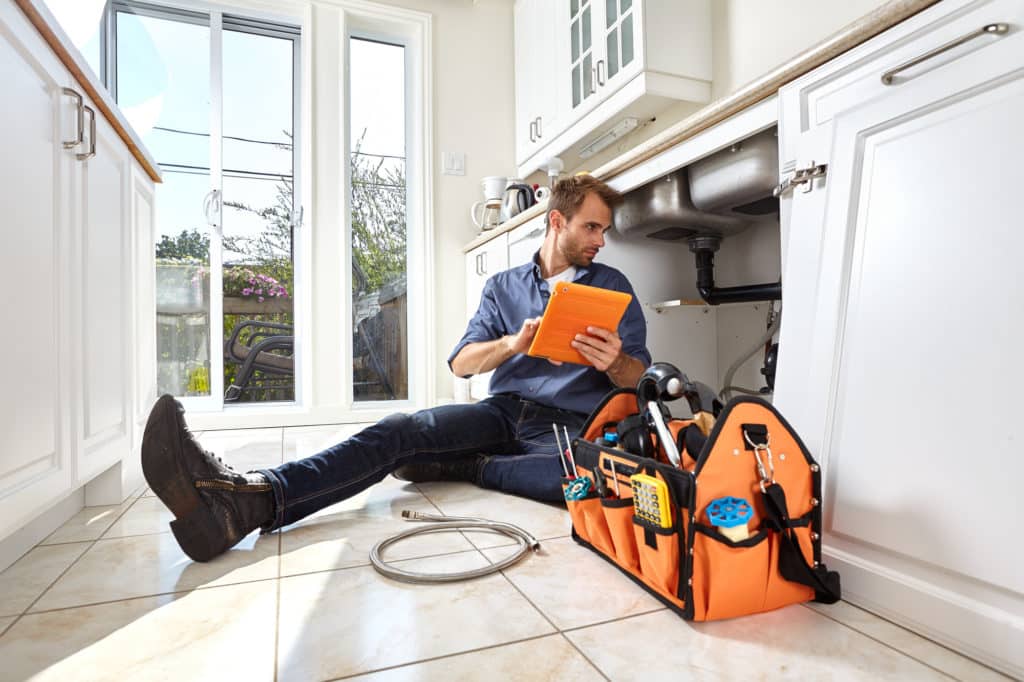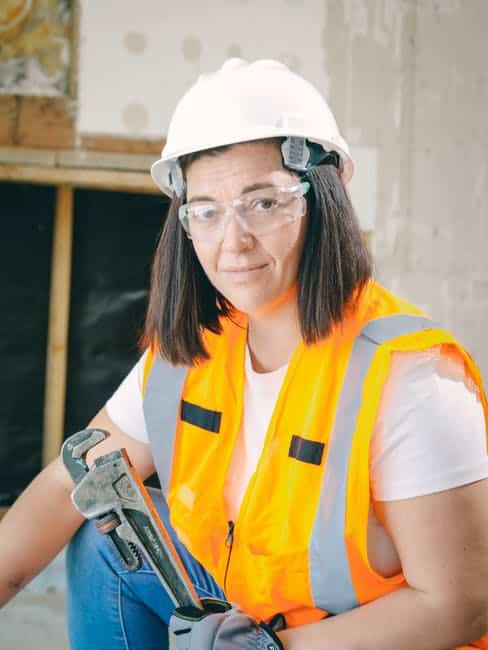Detecting and tracing water leaks is essential to safeguard your home from damage and save on excessive water bills. If you’re in a hurry and need to identify a leak source quickly, here’s what you can do:
- Monitor your water bill for unusual increases.
- Use your water meter to check for leaks by noting changes when no water is used.
- Look for visible signs like wet spots, mold, or mildew on walls, ceilings, and floors.
- Listen for the sound of running water when all taps are off.
Water leaks can vary from blatantly obvious to sneakily hidden within the structure of your home. For busy homeowners, knowing how to efficiently trace and identify these leaks is vital to maintaining a safe and dry home.
Leaks not only threaten the integrity of your home but can also lead to skyrocketing water bills. Early detection is key to avoiding these problems. Whether it’s a slight discoloration on the ceiling indicating a hidden leak or a noticeable puddle under the dishwasher, recognizing these signs early can save you from costly repairs down the line.
In this guide from Plumbing Pros DMV, we’ll cover everything from the simplest indications of a leak to the advanced techniques professionals use for detection. Our goal is to equip you with the knowledge to act fast and effectively in the face of a potential leak, ensuring the well-being of your home.
Identifying Common Signs of Water Leaks
When it comes to tracing water leaks in your home, being vigilant about the common signs can save you from potential damage and expensive repairs. Here’s what to look out for:
Visible Signs and Wet Spots
- Discoloration on Walls or Ceilings: Water stains can appear as darker spots on plaster, indicating a possible leak.
- Puddles or Wet Spots: Unexplained puddles around appliances, toilets, or under sinks are clear signs of leaks.
Utility Bills and Water Meter Changes
- Unexpected Increase in Water Bills: A sudden spike in your water bill could mean water is leaking somewhere.
- Water Meter Changes: If the meter continues to change despite all water being shut off, it’s likely you have a leak. Plumbing Pros DMV suggests turning off all the water in your home, then checking the meter now and after a few hours.
Mold, Mildew, and Musty Odors
- Mold and Mildew: Persistent moisture from a leak provides a perfect breeding ground for mold and mildew, often visible in corners, on walls, or ceilings.
- Musty Odors: A musty smell without a visible source can indicate mold growth behind walls or under floors due to a hidden leak.
By keeping an eye out for these signs, you can catch water leaks early and mitigate the damage. If you’re ever in doubt, it’s best to consult with a professional like Plumbing Pros DMV to ensure your home remains safe and dry.
In the next section, we’ll delve into the initial steps to trace a water leak, providing you with actionable advice to detect and address leaks promptly.
Tracing water leaks early can save you from potential headaches and high expenses down the line. If you suspect a leak, here are the initial steps you should take to confirm and locate it:
Shut Off Water
The first step is straightforward but crucial. Shut off all water in your home. This includes taps, washing machines, dishwashers, and any appliance that uses water. By doing this, you ensure that any movement in the water meter is due to a leak and not regular usage.
Check Water Meter
Find your water meter, which is typically located outside your house near the curb or in your basement. Once all the water is turned off in your house, observe the meter. Many meters have a leak indicator, a small dial or wheel that spins when water flows through the meter. If this indicator is moving, you likely have a leak. For a more detailed check, take a meter reading, wait for 1-2 hours without using any water, and then take another reading. If the readings are different, it confirms a leak. This method is a practical approach mentioned in discussions on platforms like Reddit.
Monitor Your Water Bill
An unexpected rise in your water bill can signal a leak. If your usage habits haven’t changed but your bill is creeping up, it’s worth investigating. Monitoring your bill can provide you with a clue that there’s a leak somewhere in your home.
Use Leak Indicator
Some modern water meters come equipped with a leak indicator feature. This feature can be a tool in the meter’s interface that signals abnormal water flow, suggesting a potential leak. Referencing your meter’s manual can guide you on how to use this feature effectively.
Taking these initial steps can help you confirm if there’s a leak. However, finding the exact location of a leak, especially if it’s hidden, can require more advanced techniques or professional help.
In the next section, we’ll explore advanced techniques for detecting water leaks, including the use of professional tools and services that can pinpoint the location of leaks with precision, ensuring that repairs are targeted and effective.
Advanced Techniques for Detecting Water Leaks
Discovering the exact source of a water leak in your home can sometimes feel like searching for a needle in a haystack. However, with the right tools and knowledge, tracing water leaks can be much simpler. Let’s dive into some advanced techniques that professionals use to detect water leaks efficiently.
Thermography and Infrared Imaging
One of the most effective ways to trace water leaks is through thermography and infrared imaging. This technology uses cameras to see areas of moisture in walls, floors, and ceilings by detecting temperature differences. Leaks often cool the area around them, making them visible to these cameras. This method is non-invasive and can quickly locate a leak without the need for demolition or guesswork.
For an in-depth look at how this works, check out the explanation on infrared thermographic pipeline testing which shows its accuracy and efficiency in detecting leaks.
Acoustic Sensors
Leaks create noise as water escapes from pipes, often at frequencies too low for human ears to detect. Acoustic sensors can pick up these sounds, allowing plumbers to pinpoint the location of a leak. These sensors are especially useful for underground or hidden pipes where visual inspection isn’t possible. The technology has evolved to provide clearer, more distinct sounds, making it easier to analyze and locate the source of a leak.
Professionals at companies like Plumbing Pros DMV use advanced acoustic listening equipment to detect these sounds and estimate the leak’s location with remarkable accuracy.
Professional Plumbers’ Tools
In addition to thermography and acoustic sensors, professional plumbers have a range of specialized tools at their disposal for tracing water leaks. These include:
- Listening Discs and Ground Microphones: Amplify the sound of leaks through materials like drywall and concrete.
- Pressure Loggers: Monitor the pressure in water lines to identify drops that indicate a leak.
- Utility Line Location Equipment: Detects electromagnetic fields from underground pipes, helping to trace the path of water lines and identify where leaks might occur.
These tools, combined with the expertise of seasoned professionals, make it possible to locate leaks with precision and minimal disruption to your property.
The Importance of Professional Assessment
While some leaks are straightforward and can be traced through visual inspection or simple DIY methods, many require the advanced techniques mentioned above. Professional leak detection services employ these methods not just to find the leak but to do so in a way that prevents unnecessary damage to your home.
For homeowners, this means saving time, money, and the hassle of dealing with extensive repairs. By understanding the advanced techniques used in the industry, you can see the value of bringing in professionals like Plumbing Pros DMV for accurate, efficient leak detection.
In the next section, we’ll explore DIY methods for locating water leaks, offering practical tips for those instances when professional help might not be immediately available.
DIY Methods for Locating Water Leaks
When you suspect a water leak in your home, there are several straightforward techniques you can employ before seeking professional assistance. These methods can help pinpoint the source of a leak, potentially saving you time and money. Let’s dive into some effective DIY strategies for tracing water leaks.
Food Coloring Test
One of the simplest yet effective methods is the food coloring test, particularly useful for identifying toilet leaks. Here’s how to do it:
– Remove the lid of the toilet tank and add a few drops of food coloring.
– Wait for about 15-30 minutes without flushing.
– Check the toilet bowl. If the colored water has made its way to the bowl, you have a leak from the tank to the bowl. This usually indicates a faulty flapper or valve seal.
Dye Tablets
Similar to the food coloring test, dye tablets offer a mess-free alternative. These are often available for free from local water authorities or can be purchased at a minimal cost from hardware stores. The process is the same as the food coloring test, providing a clear indication of a leak when dye appears in the toilet bowl.
Listening for Running Water
Believe it or not, your ears can be powerful tools in detecting leaks. Late at night or during quiet hours, turn off all appliances and listen carefully in your home. Pay special attention to walls and floors. The sound of running water when all taps are turned off is a strong indicator of a leak. This method often requires patience and a very quiet environment to be effective.
Checking Appliances
Leaks often come from household appliances that use water. Here’s a checklist:
– Washing Machines: Inspect the hoses for any signs of cracks, wear, or water leakage.
– Dishwashers: Check around and under the appliance for any signs of wet spots or corrosion.
– Refrigerators: If your fridge has an ice maker or water dispenser, examine the water line connections for drips or moisture.
By using these DIY methods, you can often identify the more obvious leaks in your home. However, some leaks may be hidden or too small to detect without professional equipment. If your leak persists or you cannot identify its source, it might be time to call in experts like Plumbing Pros DMV. They have the tools and expertise to locate and repair leaks efficiently, preventing further damage to your property.
In the next section, we’ll explore professional tools and services that can take leak detection to the next level, ensuring your home stays dry and damage-free.
Professional Tools and Services for Leak Detection
When it comes to tracing water leaks effectively, especially those that are not immediately visible or easy to locate, a range of professional tools and services come into play. These advanced solutions offer precision and efficiency, significantly reducing the time and effort required to identify the source of a leak.
Thermography Cameras
Thermography or infrared cameras are pivotal in professional leak detection. They work by detecting temperature variations in walls, floors, and ceilings, allowing experts to identify damp areas caused by water leaks. The cooler temperatures of a leak contrast with the surrounding structure, making it visible on the camera’s display. This method is non-invasive and provides a clear picture of where the problem lies without the need for immediate excavation or wall removal.
Acoustic Sensors
Another sophisticated approach involves the use of acoustic sensors or ground microphones. These devices can detect the sound of water moving through pipes or leaking out. By amplifying these sounds, professionals can pinpoint the exact location of a leak, even when it’s hidden deep within walls or under floors. This technology is particularly effective in noisy environments where the sound of a leak might be drowned out by other sounds.
Water Leak Detectors
Several brands offer specialized water leak detectors designed for residential and commercial use. Devices from Aqara, D-Link, Eve, Kidde, Moen, Swann, and X-Sense come with features like Wi-Fi connectivity, remote monitoring through smartphone apps, and automatic shut-off functions to prevent water damage. These detectors can be placed in areas prone to leaks, such as under sinks, near water heaters, or in basements, providing real-time alerts to homeowners.
Professional Grade Equipment
For the most challenging leak detection tasks, tools like the General Wire GR-LE Gen-Ear LE and the Moen Flo Smart Water Monitor & Shutoff system are used by professionals. The Gen-Ear LE is an acoustic leak detection system that helps locate leaks in underground pipes. Meanwhile, the Moen Flo offers not only leak detection but also the capability to shut off the water supply automatically in case of a detected leak, potentially saving thousands in damages.
Specialized Services
Companies like Plumbing Pros DMV not only use these advanced tools but also bring years of experience and expertise to the table. Their services include detailed inspections, precise leak detection, and effective repair solutions. Whether it’s a residential property or a commercial building, having a professional evaluate the situation can make all the difference in preventing extensive water damage.
PQWT L2000
The PQWT L2000 is a specialized water leak detection system designed for detecting leaks in underground pipes. It uses advanced technology to sense the sound of water escaping from pipes, making it invaluable for municipal water systems and large facilities. Its accuracy and range make it a go-to solution for challenging environments where leaks are difficult to locate.
In summary, tracing water leaks efficiently requires a blend of the right tools, technology, and expertise. Homeowners facing leak issues should consider engaging professional services equipped with the latest in leak detection technology to ensure a quick resolution and minimal damage. Regular maintenance and inspections by professionals can also help identify potential problems before they escalate, keeping your home safe and dry.
In the next section, we’ll delve into preventive measures and regular maintenance tips to help homeowners stay ahead of water leaks and protect their property from potential damage.
Preventive Measures and Regular Maintenance
Taking proactive steps and performing routine maintenance are key strategies in preventing water leaks and minimizing potential damage to your home. By incorporating these practices into your home care routine, you can safeguard your property and ensure your plumbing system operates efficiently.
Annual Inspections
An annual inspection by a professional plumber is a cornerstone of good plumbing health. During these inspections, a plumber can spot early signs of wear and tear, corrosion, or potential leak points in your plumbing system. It’s a proactive approach that can save significant money and hassle down the line.
Checking Irrigation Systems
For homes with lawns and gardens, regular checks of the irrigation system can prevent leaks that waste water and damage your property. Early spring, before you turn your system on for the first time, is an ideal time to inspect for damage caused by freezing temperatures or wear and tear. Look for cracked lines, broken sprinkler heads, or leaks at the connection points.
Replacing Rubber Hose Gaskets
Outdoor spigots and hoses are common sites for leaks. Over time, rubber hose gaskets can deteriorate and fail, leading to water waste and potential entry points for water into your home’s foundation. Inspecting and replacing these gaskets annually is a simple, cost-effective way to prevent such issues.
Inspecting Water Heater Connections
Water heaters are another potential source of leaks. Regularly inspecting the connections, the tank itself, and the surrounding area for signs of leaks can prevent water damage. Additionally, setting the temperature correctly can reduce wear and tear on the system, extending its life and preventing leaks caused by overpressure.
Preventive maintenance isn’t just about avoiding leaks; it’s about ensuring the efficiency and longevity of your home’s plumbing system. Taking these steps can lead to significant savings by avoiding costly repairs and water waste.
By adhering to these preventive measures and scheduling regular maintenance, homeowners can significantly reduce the risk of water leaks. While unforeseen issues can still arise, being proactive in your home’s plumbing care can help catch and resolve problems before they escalate into major concerns.
Frequently Asked Questions about Tracing Water Leaks
How do plumbers detect hidden leaks?
Plumbers have a variety of techniques at their disposal for tracing water leaks. One common method is a visual inspection, where they look for signs of water damage, mold, or discoloration. If the leak isn’t immediately apparent, they might use specialized equipment such as listening discs or ground microphones. These tools allow plumbers to hear the sound of water leaking within walls, floors, or underground pipes. Pressure testing is another technique, where plumbers close off all outlets and assess whether the pressure is maintained, helping to identify leaks. Furthermore, infrared cameras can detect temperature variations caused by water leaks, offering a non-invasive way to find hidden moisture behind walls or in ceilings. For more detailed insight, this explanation offers a comprehensive overview of the process.
Is there a tool to detect water leak?
Yes, several tools can help in detecting water leaks. For homeowners, simple devices like water leak detectors can be placed in areas prone to leaks, such as near washing machines, water heaters, and under sinks. Brands like Aqara, D-Link, Eve, Kidde, Moen, Swann, and X-Sense offer products designed for home use. For more advanced detection, professionals use tools like the General Wire GR-LE Gen-Ear LE, Moen Flo Smart Water Monitor & Shutoff, and PQWT L2000, which are capable of identifying even the most elusive leaks. These devices utilize technologies ranging from acoustic sensors to thermography cameras, making them incredibly effective at locating leaks without needing to tear into walls or dig up yards.
How do I find out where my water is leaking from?
Finding the source of a water leak can sometimes be a straightforward process, especially if there are visible signs of water damage. However, for hidden leaks, you might start with a simple test: ensure no water is being used in your home and check your water meter. If the meter’s leak indicator is moving or if you notice a change in the meter reading over a couple of hours, you likely have a leak. Listening for the sound of running water when all taps are off can also hint at a leak’s location. Checking appliances and fixtures for leaks is another step you can take on your own. If these methods don’t reveal the leak, it may be time to call in a professional. Plumbers can use more advanced tools and techniques, as described earlier, to locate the leak for you. For a more detailed discussion on DIY methods for locating water leaks, this Reddit thread provides practical advice and shared experiences from homeowners.
Tracing water leaks and identifying their sources efficiently requires a mix of observation, simple tests, and sometimes, the intervention of professional tools and expertise. Whether you’re tackling the issue yourself or enlisting the help of a professional, early detection is key to preventing extensive damage and costly repairs.
Conclusion
When it comes to tracing water leaks, vigilance and prompt action can save you from a world of trouble. Water leaks, if left unaddressed, can lead to significant damage to your property, not to mention a hefty bill for repairs and water loss. Identifying the common signs of water leaks, such as wet spots, mold, and unexpected spikes in your water bill, is the first step towards safeguarding your home.
For the initial tracing of water leaks, simple steps like monitoring your water meter, checking for visible signs of leaks, and using leak indicators can be incredibly effective. However, when these initial steps don’t lead to a resolution, it might be time to employ more advanced techniques or call in the professionals.
Professional plumbers have access to sophisticated tools like thermography cameras and acoustic sensors, which can detect leaks hidden behind walls or under floors without the need for invasive procedures. These tools, combined with their expertise, can accurately pinpoint the source of a leak, saving you time and money in the long run.
For those inclined towards DIY methods, simple tests like the food coloring test for toilets or listening closely for the sound of running water can also be quite revealing. However, always remember that some leaks may require professional attention, especially if they’re located in hard-to-reach places or involve complex plumbing systems.
Investing in professional leak detection services, such as those offered by Plumbing Pros DMV, can provide peace of mind and prevent potential disasters. These services not only help in efficiently tracing and fixing leaks but also in implementing preventive measures to avoid future leaks.
In conclusion, whether you decide to tackle leak detection on your own or seek professional help, the key is to act swiftly. Regular maintenance, being observant of the signs, and knowing when to call in the experts are all crucial steps in managing water leaks effectively. The cost of prevention is always less than the cost of repair. Stay vigilant, and keep your home safe and dry.
